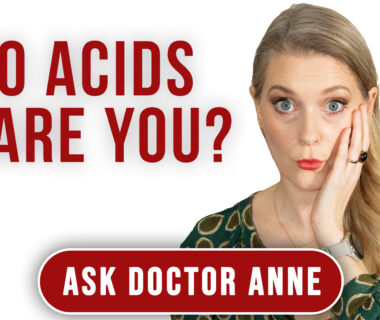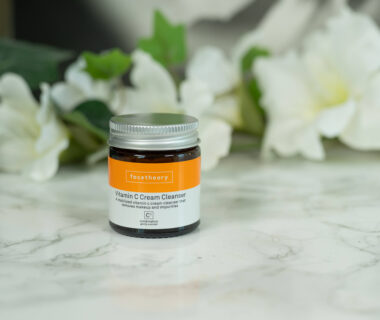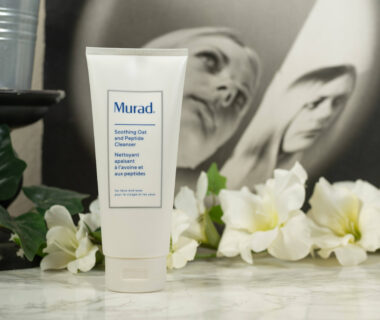ADVERTISEMENT INFO: THIS BLOG POST CONTAINS GIFTED ITEMS (PR) AND USES AFFILIATE LINKS. I RECEIVED NO MONEY TO WRITE IT. PLEASE READ DISCLAIMER.
Although for me that was like 100 years ago, I still remember how confusing being a teenager is. So today I am here to make sure that among the many things that are confusing right now – falling in love, growing in unexpected places, figuring yourself out – that among all these confusing things, one thing is clear and easy: Picking the best skincare routine for teenage skin!

So whether you are one of these people that slide into my DMs to ask me if age 14 is too early to use a peptide serum – yes!- or if you are the parent to one and want to offer some guidance, I am here to help.
Teenage acne
I want to start with a few words on acne, as it is a very common skin condition in western countries. Approximately 85% of adolescents and young adults do suffer from various degrees of acne at least for a certain period of time. The fact that it is that common though does not mean that it can be shrugged off as something „you’ll grow out of“ – skincare concerns should be taken seriously no matter the age and be addressed accordingly.
So when are the breakouts a relevant concern? Well, the easiest answer is: When they start to bother you. Other, more „objective“ signs would be a change from skin congestion aka blackheads and whiteheads to more deep set pimples, the frequency with which they occur and of course if they leave any marks or scars.
Whenever scarring happens, you should go see a dermatologist, as preventing scars is much easier than treating them.
Other skin conditions that could manifest or worsen around this time in your life are psoriasis and eczema, although their first manifestation most commonly happens in small children.
But why do all these changes suddenly happen?
The changes in teenage skin
As it is often the case, our hormones are to blame. When you reach puberty, and even before that, in pre-puberty, the sex hormones start to increase, the androgens much more than the estrogens. They trigger growth, make facial hair appear, change your voice by changing the size of your larynx and increase the size of your sebaceous glands.
If you didn’t know that by now, your sebaceous glands are in the side of your hair follicles or pores and produce sebum to help your skin stay moisturized.
Bigger glands means more sebum, and this excess along with dead skin cells can clog up the pore and either oxidize, becoming a blackhead, or build up pus, becoming a whitehead.
As your hormones don’t steadily increase until they reach the optimum level, but instead go up and down and up and down – something you better get used to, especially as a woman, as I sometimes feel it will stay that way for the rest of your life! – as they go up and down, your skin will get more or less oily, have more or less congestion, so another thing that is constantly changing in these chaotic years.
Being a teenager does have some advantages though, at least in terms of skin. Both your skins desquamation, the process of shedding the dead skin, and your skins collagen and elastin production function at optimum level, which means: you have the glowy, perky skin by default that people my age have to work hard for.
What is the best skincare routine for teenagers?
And by „the best“ I don’t mean expensive or complicated, quite on the contrary. Your skincare routine should be simple and focus on three things:
- Cleansing
- Moisture
- Protection
To figure out the best products for you as an individual, you should get to know your skin. Is it oily and you feel that after washing your face in the mornings, a few hours later it is already covered in an oil film again? Or does it feel tight, maybe itchy and has a tendency for dry patches?
I don’t believe in the strict concept of „skin types“, as your skin will change a million times throughout the years, influenced by the season, your stress levels, your age and, you guessed it: hormones, but having this basic understanding on what your skin leans toward really helps picking the right products. (If you need some guidance I have a post on that here)
Now is the time to get to know your skin and its needs, it will pay off in the long run.
Cleansing for teenage skin
Cleansing is a very important step in your skincare routine, no matter your age, but especially in these more oily days. And cleansing is much more complex than it sounds, from figuring out the right products to the right frequency, it is much more than just splashing your face with water.
Starting with the products, it all comes down to your skin, but the two things that you should always look for in your products are that it is gentle and pH balanced.
What does that mean? Well, a gentle cleanse is one that gets rid of the dirt and excess sebum, but without drying out the skin. You want your skin to feel fresh and clean, but never tight or „squeaky clean“. A gentle cleanser also does not contain any actives or scrubbing particles, as using them daily usually does more harm than good.
Exception of the rule here: If you suffer from congestion, a salicylic acid cleanser could be a great pick to help prevent that.
The pH is important because your skin is slightly acidic, and it needs to be in order to function its best. So if you just grab a soap, which is more alkaline, you will raise your skins pH, making it lose more water and be more prone to foreign invaders that could lead to breakouts.
For texture: Usually more oily skins prefer foaming cleanser, more dry skins prefer milk types, but in the end both can be gentle and pH balanced, so just go by your preference.
If you are unsure, you can read more about How to pick the right cleanser for your skin type here.
Some of my favorite picks are
- Geek and Gorgeous Jelly Cleanser (150ml/ 11 €), as it is gentle, pH balanced and enough to remove light layers of makeup (full review here)
- Good Molecules Daily Rosewater Cleansing Gel (120 ml/ 12 $), similar to the Geek & Gorgeous option (full review here)
- The Ordinary Squalane Cleanser (150ml/ 19 €) if you want something more hydrating
- The Inkey List Oat Cleansing Balm (150 ml/ 11 €), which is very soothing and great at removing makeup (full review here)
- Pixi Clarity Cleanser (135 ml/ 20 €) if you want something with salicylic acid in it (full review here)
- Cerave Cleansers (250 ml/ 11 €), both with and without Salicylic Acid (I have not used them myself, but they come with high praise)
You might have noticed that all of these are on the more affordable side and that some of my personal favorites are not among them. That is because I don’t think your teenage years are the time to spend lots of money on your skincare, simply because you don’t have to and there are more important things in your life right now.
How often should you cleanse your face?
And should you do a single or a double cleanse?
That depends.
If your skin is oily and prone to breakouts, cleansing your face morning and night is a good idea. If it is more on the dry side, a thorough cleanse at night and just some water in the mornings is fine.
The evening cleanse is however non-negotiable, especially if you are already wearing makeup. I didn’t wear foundation when I was a teenager, but then again that was the middle-age while the earth was still flat, so things might be different for you.
If you wear heavier makeup (think foundation, contour, brow and highlight), you need to remove that first and then cleanse your skin. If you remove it with your cleanser and then go in with the same cleanser for a second round or use a makeup remover and then your cleanser is up to you – the only rule you need to follow is don’t use a salicylic acid cleanser to remove your eye makeup. (I talk more about Double Cleansing in this post here)
The best moisturizer for teenage skin
And yes, before you ask, you can skip the toner, serum, sheet mask stuff. Your skin is functioning at optimum level when it comes to collagen and cell turnover, you don’t need extra exfoliation or collagen stimulating ingredients.
What you need is to make sure your skin is well hydrated, and to keep it that way, you need a good moisturizer to reduce TransEpidermal Water Loss (TEWL). Which one you prefer again comes down to your skin.
More oily skins usually prefer gel type formulas or lightweight lotions, while dry skin prefers the richer textures. When in doubt, I would always start with the lighter version and then see how the face feels within a few hours. If it is tight, you need something richer, if it is too oily, something lighter.
Not moisturizing in an attempt to „dry out the oils“ might actually backfire, as your skin will try and make up for the lack of oils by producing more of its own. Which, before you ask, does not function the other way around: Oiling up the skin will not make the sebum production decrease, as it is mostly stimulated by your hormones.
If your skin is very oily, you can replace the moisturizer with your sunscreen in the mornings to reduce the amount of layers on your skin.
My recommendations would be
- Neutrogena Hydro Boost (50 ml/ 10 €), which has different options for different skin types, like the Aqua Gel, the Aqua Cream and the original one
- Cerave moisturizers (470 ml/ 10 €), again with different options for different „skin types“
- If you are in the UK, the Sam Farmer products (50 ml/ 6 GBP), which are unisex and affordable
If you want, you can use something light in the mornings and something richer at night, or, as I mentioned before, something light at night and just your sunscreen in the mornings, but you can also use the same product both mornings and night.
Protection aka sunscreen
The first and most important step, and the one that I want you to do even if you don’t do anything else, is wearing sunscreen. It will protect you from premature aging, will prevent hyperpigmentation when you reach my age and of course offers protection against skin cancer. It also helps reduce acne severity if you manage to find the right one (which can be a struggle, I know that).
Speaking of the right one, this again comes down to personal preference and your skin, but it should provide at least medium protection, so around an SPF of 30 on an average day (SPF 50 is of course better, just to be sure) and broad spectrum protection. I have a lot of blog posts on that topic which you can find here, but in short: The best sunscreen for you is the one that you like enough to wear daily.
My personal favorites would be
- Bioré Aqua Rich UV Essence SPF 50 (50g/ 11 €), as it is very lightweight and great for oily skin (full review here)
- La Roche Posay Shaka Fluid SPF 50 (50 ml/ 13 €), which also comes in waterproof if you do outdoor sports and such (full review here)
Lifestyle tips for teenage skin
Good skin needs more than products!
Eat a balanced diet, sleep enough, always remove your makeup before bed, cleanse your makeup brushes properly, don’t pick at your skin and, should you ever have any skincare concerns, seek professional help.
An early consultation with a dermatologist is much better than trying to solve acne on your own, and if you get the chance to go for a facial, maybe as a birthday treat, at a good esthetician, one that takes the time to educate you about your skin rather than sell you a bunch of products, you are well on your way to many years of beautiful skin.
But what about the serums and face masks for teenage skin?
As I said before, you probably don’t need them. But if you want some, just because, and I totally get that, here is what I recommend:
- Salicylic Acid: most teenagers suffer from congestion, especially in the t-zone, and salicylic acid is great to help with that. Instead of using it in your face wash, you can get it as a leave on product and use that once or twice a week. My personal favorite is The Ordinary 2% Salicylic Acid (30 ml/ 8 €, full review here), but there are many other options available – just look for a concentration of 1-2%
- Niacinamide: this ingredient is a great allrounder, it can help control sebum production, is antiinflammatory, increases hydration and even helps with hyperpigmentation. (I talk in depth about the ingredient here) It is often part of your moisturizer already, but as a serum I recommend The Ordinary Niacinamide 10% + Zinc 1% (30 ml/ 6 €, full review here), which I love myself. Again, there are other options by other brands – a concentration of 5 to 10% is what you should be looking for
- Hydration: To be honest, I don’t think face masks are necessary in a skincare routine, but I acknowledge the selfcare aspect they have, so if you want one as a weekly ritual, opt for one that boosts hydration. Rinse off or sheet mask is again up to your personal preference, just pick what feels more relaxing.


